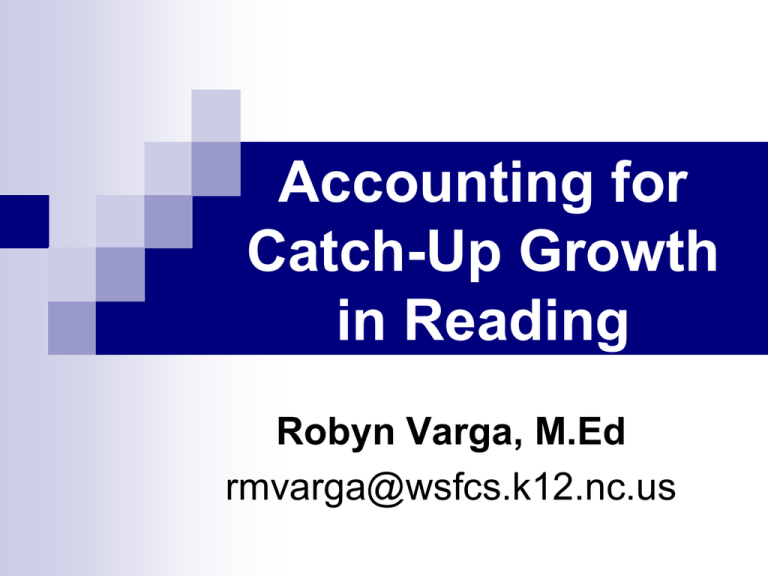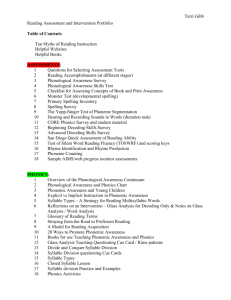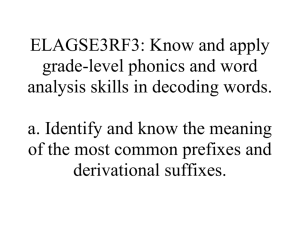Accounting for Catch-Up Growth in Reading Robyn Varga, M.Ed
advertisement

Accounting for Catch-Up Growth in Reading Robyn Varga, M.Ed rmvarga@wsfcs.k12.nc.us LANGUAGE COMPREHENSION BACKGROUND KNOWLEDGE VOCABULARY KNOWLEDGE LANGUAGE STRUCTURES VERBAL REASONING SKILLED READING: fluent execution and coordination of word recognition and text comprehension. LITERACY KNOWLEDGE WORD RECOGNITION PHON. AWARENESS DECODING (and SPELLING) SIGHT RECOGNITION Reading is a multifaceted skill, gradually acquired over years of instruction and practice. Literacy Developmental Sequence K 1st 2nd 3rd Vocabulary P.A. Decoding (Phonics) Fluency Comprehension 4th 5th – 12th Literacy Development Many fundamental skills develop in stages. The stages cannot be skipped – regardless of the age of the learner. Intervention must match the developmental level and proceed from there. How Students Learn to Read Intensive Targeted Universal 20% -Reading is One of the Most Difficult Tasks to Be Mastered Few Some 40% -Reading is A Formidable Challenge 35% -Reading is Relatively Easy All 5% -Reading is Easy Adapted from NCSIP Foundations of Reading Targeted Accelerated Growth Diagnostic Assessments to determine deficient sub-skills Targeted interventions to teach to the deficient skill Set goal based on norms and catch-up growth Progress Monitor to assure catch-up growth is occurring Educators as Physicians Adapted from 3/25/14 Jan Hasbrouck, Ph.D. Presentation Treatment without Diagnosis is Malpractice Educators as Physicians Screening/Benchmark Testing: “universal screening” “So, how are you doing?” Educators as Physicians Diagnostic Assessments: “Let’s see what’s going on…” Educators as Physicians Provide effective INSTRUCTION! “This is what we’ve found…and here’s what we can do.” Educators as Physicians Progress Monitoring: “How are things going?” “Are you feeling better?” General Model of Assessment • Beginning of the year Benchmark Screening Informal Diagnostics Throughout the year • Benchmark Screening • Progress Assessments • End of the year, course, or treatment Benchmark Screening Outcome Measures Formative (to plan instruction) and summative tests (to document intervention effectiveness) can be given anytime during the year. Targeted Accelerated Growth Diagnostic Assessments to determine deficient sub-skills Targeted interventions to teach to the deficient skill Set goals based on norms and catch-up growth Progress Monitor to assure catch-up growth occurred Model of Reading Assessment: Grades K-2 Phonological Awareness Print Concepts Grades 3 and Above Decoding and SightWord Knowledge Fluency in Context Automatic Word Recognition Vocabulary Background Knowledge Knowledge of Text and Sentence Structures General Purposes for Reading Language Comprehension Reading Comprehension Strategic Knowledge Specific Purposes for Reading Knowledge of Strategies for Reading McKenna & Stahl 2009 Phonological Awareness Print Concepts Decoding and SightWord Knowledge Fluency in Context Automatic Word Recognition Vocabulary Background Knowledge Knowledge of Text and Sentence Structures General Purposes for Reading Language Comprehension Name: Bailey Maze/Daze Reading Below Grade Level Comprehension Strategic Knowledge Specific Purposes for Reading Knowledge of Strategies for Reading McKenna & Stahl 2009 Phonological Awareness Print Concepts Decoding and SightWord Knowledge Fluency in Context 1) CORE Fluency 2) Graded HF Word Below Grade Level Automatic Word Recognition Vocabulary Background Knowledge Knowledge of Text and Sentence Structures General Purposes for Reading Language Comprehension Reading Comprehension Strategic Knowledge Specific Purposes for Reading Knowledge of Strategies for Reading McKenna & Stahl 2009 CORE Phonics Survey Results: Below Grade Level Phonological Awareness Print Concepts Decoding and SightWord Knowledge Fluency in Context Automatic Word Recognition Vocabulary Background Knowledge Knowledge of Text and Sentence Structures General Purposes for Reading Language Comprehension Reading Comprehension Strategic Knowledge Specific Purposes for Reading Knowledge of Strategies for Reading McKenna & Stahl 2009 PAST Phonological Awareness Test Results: Not Proficient Phonological Awareness Print Concepts Decoding and SightWord Knowledge Fluency in Context Automatic Word Recognition Vocabulary Background Knowledge Knowledge of Text and Sentence Structures General Purposes for Reading Language Comprehension Reading Comprehension Strategic Knowledge Specific Purposes for Reading Knowledge of Strategies for Reading McKenna & Stahl 2009 Phonological Awareness Print Concepts Decoding and SightWord Knowledge Fluency in Context Automatic Word Recognition Vocabulary Background Knowledge Knowledge of Text and Sentence Structures General Purposes for Reading Language Comprehension Reading Comprehension Strategic Knowledge Specific Purposes for Reading Knowledge of Strategies for Reading McKenna & Stahl 2009 Phonological Awareness Print Concepts Decoding and SightWord Knowledge Fluency in Context Automatic Word Recognition Vocabulary Background Knowledge Knowledge of Text and Sentence Structures General Purposes for Reading Language Comprehension Name: Katie Comprehension Reading Assessment Comprehension Results: Below Grade Level Strategic Knowledge Specific Purposes for Reading Knowledge of Strategies for Reading McKenna & Stahl 2009 Phonological Awareness Print Concepts Decoding and SightWord Knowledge Fluency in Context 1) CORE Fluency 2) Graded HF Word Below Grade Level Automatic Word Recognition Vocabulary Background Knowledge Knowledge of Text and Sentence Structures General Purposes for Reading Language Comprehension Reading Comprehension Strategic Knowledge Specific Purposes for Reading Knowledge of Strategies for Reading McKenna & Stahl 2009 Phonological Awareness Print Concepts Decoding Name::Katie and SightPhonics Survey Results: Word Proficient Knowledge Fluency in Context Automatic Word Recognition Vocabulary Background Knowledge Knowledge of Text and Sentence Structures General Purposes for Reading Language Comprehension Reading Comprehension Strategic Knowledge Specific Purposes for Reading Knowledge of Strategies for Reading McKenna & Stahl 2009 Phonological Awareness Print Concepts Decoding and SightWord Knowledge Fluency in Context Automatic Word Recognition Vocabulary Background Knowledge Knowledge of Text and Sentence Structures General Purposes for Reading Language Comprehension Reading Comprehension Strategic Knowledge Specific Purposes for Reading Knowledge of Strategies for Reading McKenna & Stahl 2009 Phonological Awareness Print Concepts Decoding and SightWord Knowledge Fluency in Context Automatic Word Recognition Vocabulary Background Knowledge Knowledge of Text and Sentence Structures General Purposes for Reading Language Comprehension Name: Buddy Comprehension Reading Assessment Comprehension Results: Below Grade Level Strategic Knowledge Specific Purposes for Reading Knowledge of Strategies for Reading McKenna & Stahl 2009 Phonological Awareness Print Concepts 1) CORE Fluency 2) Graded HF Word Proficient Decoding and SightWord Knowledge Fluency in Context Automatic Word Recognition Vocabulary Background Knowledge Knowledge of Text and Sentence Structures General Purposes for Reading Language Comprehension Reading Comprehension Strategic Knowledge Specific Purposes for Reading Knowledge of Strategies for Reading McKenna & Stahl 2009 Phonological Awareness Print Concepts Decoding and SightWord Knowledge Fluency in Context Automatic Word Recognition Vocabulary Background Knowledge Knowledge of Text and Sentence Structures General Purposes for Reading Language Comprehension Reading Comprehension Strategic Knowledge Specific Purposes for Reading Knowledge of Strategies for Reading McKenna & Stahl 2009 Phonological Awareness Print Concepts Decoding and SightWord Knowledge Fluency in Context Automatic Word Recognition Vocabulary Background Knowledge Language Comprehension Knowledge of Text and Sentence Structures General Purposes for Reading Name: Buddy Reading Comprehension Comprehension Assessment Results: Below Grade Level Strategic Knowledge Specific Purposes for Reading Knowledge of Strategies for Reading McKenna & Stahl 2009 WPM & Accuracy Fluency and Comprehension 90 80 70 60 50 40 30 20 10 0 Fluency Comprehension Sept Sept Oct A B A Oct B Nov A Nov Dec B A Assessment Date Jan A Jan B CORE Focused Assessments CORE Maze / DIBELS Daze / TRC CORE Fluency / DIBELS DORF CORE High Frequency Word / Vocabulary CORE Phonics Survey PAST Phonological Awareness Assessment CORE Focused Assessments CORE Maze / DIBELS Daze / TRC CORE Fluency / DIBELS DORF CORE High Frequency Word / Vocabulary CORE Phonics Survey PAST Phonological Awareness Assessment Reading Maze Comprehension Test: What Measures how well students understand text they read silently. It is based completely on the text. Every seventh word in the passage has three words to pick the correct word. Reading Maze Comprehension Test: Why Students with reading difficulties can’t use semantics and syntax to choose correct words. A reading maze can identify these students and measure changes. Reading Maze Comprehension Test/How Materials: Timer Student passages (Use the student’s independent level on the San Diego Quick Assessment to determine the level of passage to begin) Timed ~ 3 minutes The student reads silently and circles the word in the parentheses that they think correctly completes the sentence. 13 0 CORE Focused Assessments CORE Maze / DIBELS Daze / TRC CORE Fluency / DIBELS DORF CORE High Frequency Word / Vocabulary CORE Phonics Survey PAST Phonological Awareness Assessment MASI-R Oral Reading Fluency/What Measures oral reading fluency Three passages per level (grades 1-6) Can be given three times a year An error is…. A skipped word. A word is not read correctly within 3 seconds. A word is mispronounced. A word is repeatedly mispronounced later in text, each instance. An error is not…. A word is self corrected within 3 seconds. A word mispronounced due to dialect. Insertion of words. 2nd Grade Passage 92% accurate 114 wcpm _____________________________ Where do you go from here? 2nd Grade Passage 92% accurate & 114 wcpm CORE Focused Assessments CORE Maze / DIBELS Daze / TRC CORE Fluency / DIBELS DORF CORE High Frequency Word / Vocabulary CORE Phonics Survey PAST Phonological Awareness Assessment High Frequency Word List: What Can be administered in 10 minutes or less High Frequency word recognition High Frequency Word List: Why Weak readers over rely on context Can be used as a temporary quick screening to place a new student into a reading group Scoring High Frequency Word Lists One error on a list ~ INDEPENDENT level Two errors on a list ~ INSTRUCTIONAL level Three errors on a list ~ FRUSTRATION level CORE Focused Assessments CORE Maze / DIBELS Daze / TRC CORE Fluency / DIBELS DORF CORE High Frequency Word / Vocabulary CORE Phonics Survey PAST Phonological Awareness Assessment Phonics Survey :What Measures a students ability to decode letters/sounds and ultimately words. Can be used for screening, outcome, or diagnostic. Provides a baseline to determine most appropriate placement to begin instruction or remediation. Phonics Survey: Why Knowledge of individual phonemes is the foundation of automatic decoding A student must possess the ability to automatically decode words in order to comprehend material read Pseudoword reading gives insight into student understanding of phonology Phonics Survey: How Materials: CORE Phonics Survey-Record Form CORE Phonics Survey-Student Material Instructions for administering each part of the survey are included on the Record Form. A piece of paper may be used to cover the parts of the test that the student is not reading. The Alphabet Skills and Letter Sounds assessment is a mastery test. Phonics Survey – Scoring See page 43 CORE Focused Assessments CORE Maze / DIBELS Daze / TRC CORE Fluency / DIBELS DORF CORE High Frequency Word / Vocabulary CORE Phonics Survey PAST Phonological Awareness Assessment Phonological Awareness Skills Test (PAST) Scoring the PAST One error on a skill ~ INDEPENDENT level Two errors on a skill ~ INSTRUCTIONAL level Three errors on a skill ~ FRUSTRATION level Additional Assessments in CORE Phoneme Deletion (English & Spanish) Phonological Segmentation (English & Spanish) Phoneme Segmentation (English & Spanish) Phonemic Awareness (English & Spanish) High Frequency Word Survey Spanish Spelling Inventory Vocabulary Screening Now what? Targeted Accelerated Growth Diagnostic Assessments to determine deficient sub-skills Targeted interventions to teach to the deficient skill Set goals based on norms and catch-up growth Progress Monitor to assure catch-up growth occurred. Comprehension Continue Tier 1 Instruction Use Think Alouds/Graphic Organizers Reciprocal Teaching Comprehension Strategies Vocabulary Activities FCRR Activities Fluency Repeated Reads on Independent/ Instructional Level 90-98 % Accuracy Echo Reading Paired/ Partner Reads FCRR Activities High Frequency Sight Word Practice Fry Phrases FCRR Activities Phonics / Decoding Recipe for Reading Lessons Words Their Way Activities DIBELS Next Activities FCRR activities Phonological Awareness DIBELS Next Activities Sounds in Action activities FCRR Activities Florida Center for Reading Research Targeted Accelerated Growth Diagnostic Assessments to determine deficient sub-skills Targeted interventions to teach to the deficient skill Set goals based on norms and catch-up growth Progress Monitor to assure catch-up growth occurred. Considerations for Setting Goals Norms Catch-up growth Norm Charts Norm charts exist across all domains. The 50th percentile is considered “average”. 7 6 5 4 4 3 2 2 1 Progress per year 6 mo. Adapted from NCSIP Foundations of Reading 7 2 6 5 4 4 3 2 2 1 Progress per year 6 mo. 12 mo. Adapted from NCSIP Foundations of Reading 7 2 6 5 4 4 3 2 2 2 12 mo. 18 mo. 1 Progress per year 6 mo. Adapted from NCSIP Foundations of Reading Catch Up Growth All students need to make a year of academic growth each year. Students who are 1 to 3 years behind in reading need to make an additional year of growth until they catch-up. Lynn Fielding, March 2011 What Happens Early, Matters… “…the level of academic achievement that students attain by eighth grade has a larger impact on their college and career readiness than anything that happens academically in high school.” ~Lynn Fielding Achievement The Expanding Achievement Gap K 1 2 Grade in School 3 4 Fall and Winter DIBELS: Fall 5 Winter Benchmark 10 Benchmark 9 7 Strategic 7 Strategic 4 Intensive Intensive Adapted from NCSIP Foundations of Reading Targeted Accelerated Growth Diagnostic Assessments to determine deficient sub-skills Targeted interventions to teach to the deficient skill Set goals based on norms and catch-up growth Progress Monitor to assure catch-up growth occurred. Progress Monitoring: Why To determine if students are making adequate progress or need more intervention to achieve grade-level reading outcomes. Progress Monitoring: Who Students who are at risk for academic failure Progress Monitoring: When Daily, weekly, bi-monthly, monthly Progress Monitoring Tools At Risk Progress Monitoring: Kindergarten PSF Example Strategic Benchmark AAGL Student Jan 24 Feb 7 Feb 21 March March 7 21 April April May 4 18 2 Julie Anthony Dakota Sarah 3 7 5 12 8 14 4 7 19 8 17 8 17 9 19 0 5 9 10 11 9 16 8 18 10 21 11 45 12 24 Adapted from NCSIP Foundations of Reading Resources Florida Center for Reading Research: fcrr.org What Works Clearinghouse (US Dept of Education): ies.ed.gov/ncee/wwc Intervention Central: www.interventioncentral.org Easy CBM: easyCBM.com North Carolina School Improvement Project (NC SIP): ncsip.org Contact Information Robyn Varga rmvarga@wsfcs.k12.nc.us (336) 255-6951







